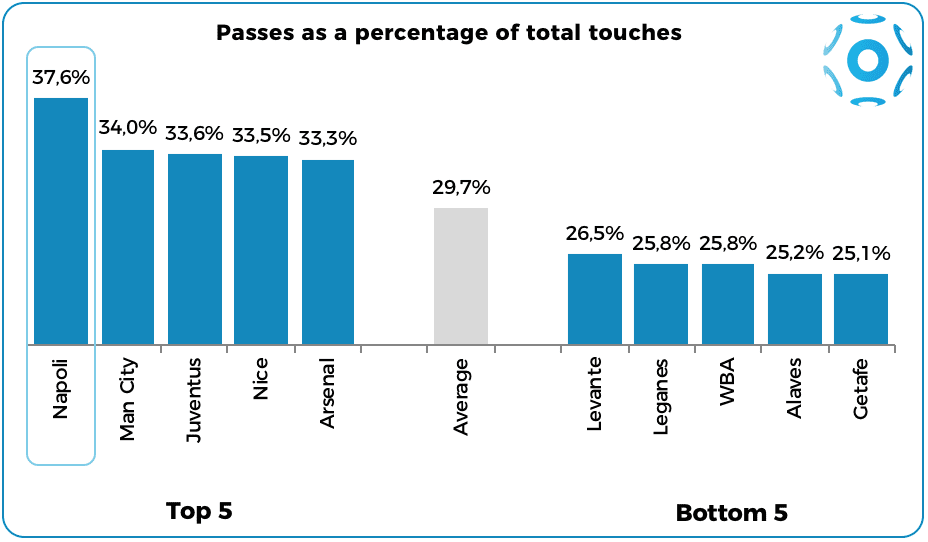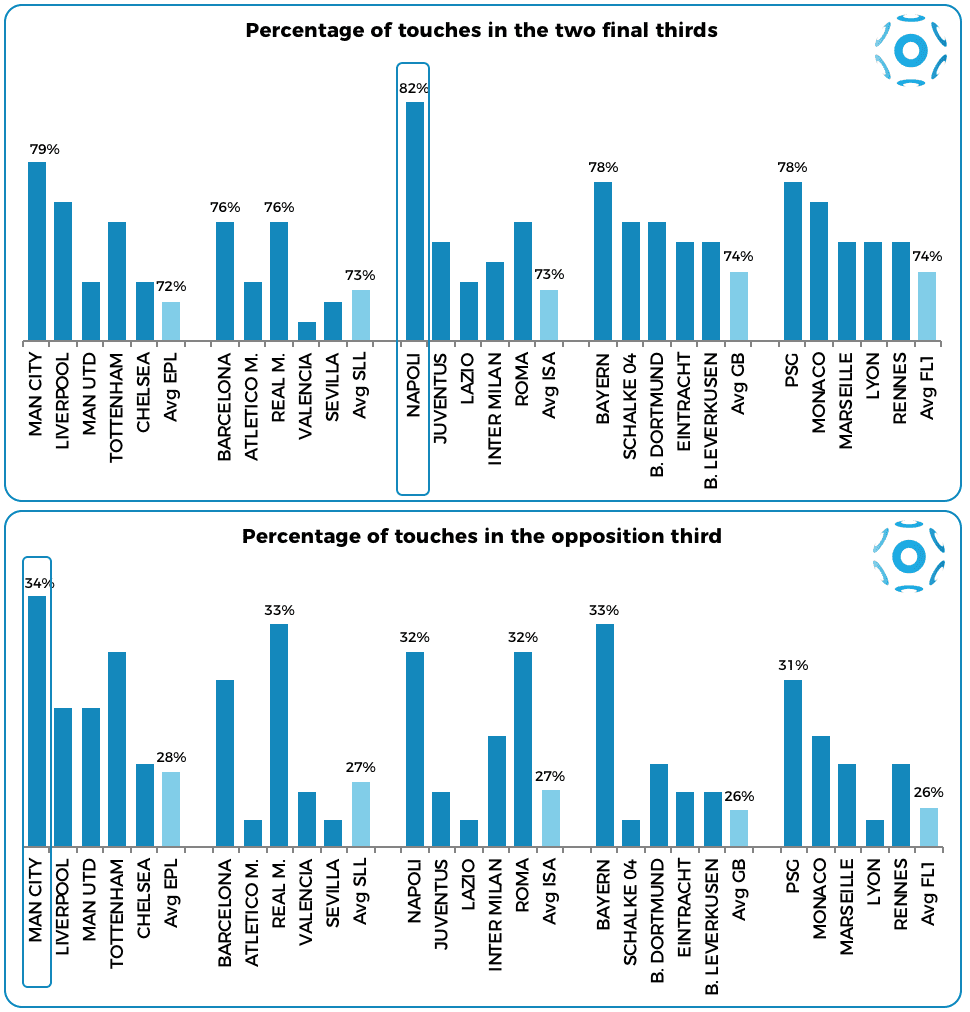Napoli is in a totally different league compared to any other team in Europe. They pass the ball every 2.65 touches (passes represent 37.6% of total ball touches).

Is Napoli’s football particularly appealing? We believe it really catches the eye. Is it effective? Well, Maurizio Sarri’s Napoli are among the teams collecting most points per match in Europe, scoring the most and conceding the least, so it seems it is quite effective as well.
Talking about Napoli, Pep Guardiola said: “They are perhaps the best side I’ve faced in my career… I am in love with Napoli, with the way they make short passes and they didn’t give us time to think in the opening 20 minutes. We didn’t have the courage to play”.
Here below, we insert the youtube video (source: Italian Association of Football Performance Analysts) of one of the most iconic goals scored by Napoli this season (2017/18): all eleven players touch the ball before Hamsik scores against Cagliari in the Italian Serie A.
Napoli touched the ball 39 times in total, including 19 passes and the final shot by Marek Hamsik. The ratio of passes on total touches stood at 48.7%. Impressive.
https://youtu.be/b6QmbeBq-Zw
IT IS WHERE YOU TOUCH THE BALL THAT REALLY MATTERS
A team playing piggy-in-the-middle in its own third would finish a match completing many passes, but scoring no goals and, probably, conceding some. This tells us that the number of passes, by itself, cannot really identify how successful a team is.
More important than the number of passes, or ball touches in a match, is therefore where on the pitch a team touches the ball. On top, we argue that the speed at which the ball is moved between the opposition’s lines is also key.
Dividing the football pitch with three hypothetical lines, we separate a team’s own third, the middle third and their opposition’s third.
Any team’s aim should be to remain in the opposition’s third most of the times, clearly. So, which are the best teams at doing that?
We looked at all the stats related to the European major leagues. In the chart below, we show the data related to percentage of ball touches in the two final thirds (middle third plus opposition third) and the stand-alone percentage of touches in the opposition third. The bars are ordered subject to the teams’ current league ranking. We show the top ranked teams in each league and the league total average. If you wish to have the numbers for a team not appearing there, do not hesitate to ask us
On the first metric, Napoli again comes up as the top team in Europe. On the second metric, probably unsurprisingly, Manchester City comes on top: Guardiola’s Man City is the team in Europe touching the ball most often in the opposition’s third.

ATTACKING FROM THE CENTRAL AREA OR FROM THE WINGS?
Another interesting feature we analyzed is where the attacks normally come from. The data provided by Opta and showed by WhoScored.com, offer some insights on the patterns that the team usually keep for their build-ups. We will develop this analysis through a video in part 3 of this trilogy, which we will publish in the next few weeks.
There are teams normally attacking from the right wing, others from the left wing. Others, instead, use the central area of the pitch more often than their competitors.

NAPOLI ATTACK FROM THE LEFT FLANK
Two European teams stand out for a much higher-than-average percentage of attacks from the left wing. Both teams play in the Italian Serie A: Napoli and Lazio, displaying a 45% and 44% percentage of attacks coming from this side, respectively.
Napoli, which plays with a 4-3-3 formation, has indeed the habit of working the ball with the left-chain (Mario Rui – Hamsik – Insigne). From the data, we see that Napoli’s left chain normally completes 50% more passes per match than the right-chain (Hysaj – Allan – Callejon): 225 passes vs 147. What normally Napoli does is, indeed, manouvring the ball from the left and look for Callejon’s fast cuts from the right, inspiring Insigne’s throughballs or crosses.

w—-https://soccerment.com/2018/03/09/ball-possession-european-football-part-2/
from: soccerment
